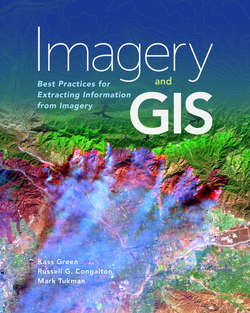Читать книгу Imagery and GIS - Kass Green - Страница 32
На сайте Литреса книга снята с продажи.
Film versus Digital Array Imaging Surfaces
ОглавлениеThe imaging surfaces of our eyes are our retinas. Cameras once used only film, but now primarily use digital (CCD or CMOS) arrays. From its beginnings in the late 1800s to the 1990s, most remote sensing sensors relied on film to sense the electromagnetic energy being reflected or emitted from an object. Classifying the resulting photographs into information required manual interpretation of the photos. In the 1960s, digital sensors were developed to record electromagnetic energy as a database of numbers rather than a film image. This enabled the development of sensors that can sense electromagnetic energy across the range from ultraviolet to radio wavelengths. Now, most remote sensing systems use digital arrays instead of film. Because the values of the reflected and emitted energy are stored as an array of numbers, computers can be trained to turn the imagery data into map information by discovering correlations between variations in the landscape and variations in electromagnetic energy. While manual interpretation is still very important, objects that are spectrally distinct from one another can be readily mapped using computer algorithms.
The imaging surface of a digital camera is an array of photosensitive cells that capture energy from incoming photons. Each of these cells corresponds to a pixel in the resulting formed image. The pixels are arranged in rectangular columns and rows. Each pixel contains one to three photovoltaic cells or photosites, which use the ability of silicon semiconductors to translate electromagnetic photons into electrons. The higher the intensity of the energy reaching the cells during exposure, the higher the number of electrons accumulated. The number of electrons accumulated in the cell is recorded and then converted into a digital signal.
The size of the array and the size of each cell in the array affect the resolving power of the sensor. The larger the array, the more pixels captured in each image. Larger cells accumulate more electrons than smaller cells, allowing them to capture imagery in low-energy situations. However, the larger cells also result in a corresponding loss of spatial resolution across the image surface because fewer cells can occupy the surface.
